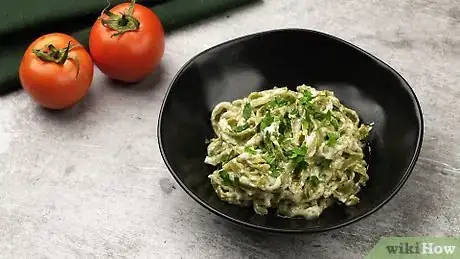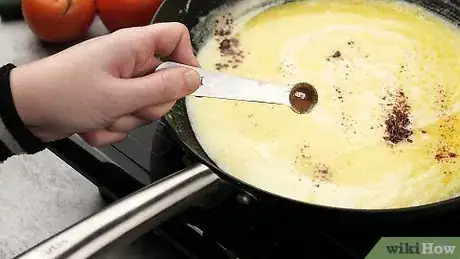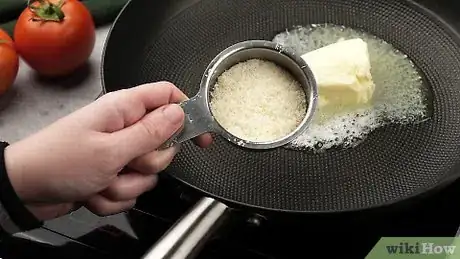This article was co-authored by wikiHow Staff. Our trained team of editors and researchers validate articles for accuracy and comprehensiveness. wikiHow's Content Management Team carefully monitors the work from our editorial staff to ensure that each article is backed by trusted research and meets our high quality standards.
The wikiHow Culinary Team also followed the article's instructions and verified that they work.
This article has been viewed 98,092 times.
Learn more...
Alfredo is a style of cream sauce made famous in 1914 by Alfredo's restaurant in Rome.[1] The earliest variations on this dish originally used only butter and Parmesan cheese. Today, however, it is most well-known as a smooth, cream-based recipe. Alfredo sauce is a versatile accompaniment for pasta, chicken, and more. Best of all, it uses only a few basic ingredients and it's ready in minutes!
Ingredients
- 1 cup heavy cream
- 1 stick (8 tablespoons) butter
- 2 cups freshly-grated parmesan cheese
- Salt and pepper (to taste)
- Water from cooking pasta (to thin sauce)
- 1-2 cloves of garlic (crushed, pressed, or minced)
- Zest of 1/2 lemon
- Juice of 1/2 lemon
- 1/3 cup white wine
- 1 cup low-fat plain yogurt
- Nutmeg (to taste)
Steps
Basic Alfredo Sauce
-
1Melt butter on the stove. Use a standard saucepan over medium-low heat. Your goal with this sauce should be to gently bring it to a warm temperature and a smooth consistency. Low, slow cooking is best. This can take patience.
-
2Stir in the cream and Parmesan cheese. Gently stir the mixture as you add the ingredients to keep them from burning or sticking. Continue stirring to combine.
- If you can, use fresh-grated Parmesan. The taste difference is noticeable compared to using pre-grated cheese. Fresh cheese also tends to be less vulnerable to "seizing." See below for an explanation.
Advertisement -
3Heat until simmering. Wait until the sauce reaches a gentle boil. Just a few small bubbles will be forming. At this point, start gently stirring until it becomes noticeably thicker. This is usually about eight minutes.[3]
- Resist the temptation to crank up the heat. Turn it down if you notice your sauce boiling rapidly. Not only can this burn your ingredients and produce an unpleasant bitter taste — it can also make your cheese "seize". When cheese is heated too quickly, the proteins in the cheese coil up rather than separating gently. This separates the fat and moisture from the cheese, leaving an unpleasantly hard product that refuses to melt.
-
4Add salt and pepper to taste. The sauce is ready to season when it's at a pleasantly thick consistency. You can add whatever seasonings you want, but plain old salt and pepper work great on their own. Stir to mix evenly after adding.
- A few shakes or pinches of each seasoning should do the trick. If you're worried about adding too much, try adding just a single pinch, stirring, and tasting the sauce. Repeat until you're satisfied!
-
5Optionally, use the pasta water to thin the sauce. If you saved the water from the pasta pot, you can use it to thin out a sauce that is too thick and rich. The water retains some of the flavor of the pasta, giving the sauce a nice "bready" flavor while thinning it.
- If you accidentally add too much water, just simmer it a little longer to thicken it again.
-
6Serve! When the sauce tastes just how you like it, it's ready to serve. Spoon steaming portions over your favorite pasta. The recipe in this section should serve about six.
- Alternatively, try using it to lend creamy flavor to your favorite meat and vegetable dishes, including chicken, shrimp, broccoli, and much more. This sauce's mild flavor is highly versatile, so you can use it for almost any entrée.
Recipe Variations
This section offers a few ideas for spicing up the basic Alfredo sauce above. You can use any combination of the tricks below, or none at all. It's up to you!
-
1Try adding a few cloves of garlic. Garlic's pungent, savory taste is the perfect accompaniment to creamy Alfredo perfection. As you melt the butter, mince a clove of garlic or two. Then, cook them on their own in the butter for about a minute before adding the rest of the ingredients. This brings out their natural flavor and aroma. Leave the garlic in the sauce as you serve it.
-
2Try adding white wine. The sweet, slightly acidic taste of most white wines adds a refined dimension to simple Alfredo recipes. Slowly mix in about 1/3 of a cup of wine just before you add the salt and pepper to the recipe. You may find that you need to simmer the sauce slightly longer to re-thicken it after adding the wine.
- Most white wines will work well. The crisp, fresh taste of Chardonnay, for instance, will elevate the dish's smoothness.[4] Avoid dessert wines like moscato, as these will be overpoweringly sweet.
-
3Try adding a twist of lemon for a citrus twist. The acidic flavor of lemon juice "cuts" the fat of the alfredo sauce. The interaction between the flavors can be tangy but mouth-watering. To add this citrus flavor to your sauce, halve a lemon while waiting for the sauce to come to a simmer. Use a fine grater or microplane to zest the peel into a small pile. Once the sauce has thickened, add the zest. Then, squeeze the juice from the lemon half in. Stir to combine.
- You may want to squeeze the lemon into the sauce through a strainer to prevent any seeds from falling in.
-
4Try adding a small pinch of nutmeg. Nutmeg may not be the first spice you'd think of that would fit well in a creamy alfredo sauce. However, in small quantities, the spice can add a savory, pleasantly aromatic quality to the dish. Try stirring in a very small pinch of nutmeg (no more than 1/4 teaspoon) when you add the Parmesan cheese. If you like the effect you get, you can keep adding more in tiny increments.
-
5Use yogurt instead of heavy cream for a lower-calorie sauce. Alfredo sauce tastes great, but one look at the ingredients list will reveal that it's calorie-dense and loaded with fat. Try substituting an equal amount of your favorite low-fat plain yogurt for the cream in the normal recipe. Greek-style yogurt is also OK. The dish will still be rich, but not as rich.
- The yogurt will also give the recipe a slightly "tangier" taste (similar to a Stroganoff sauce). Some prefer this.
- You may want to add about a tablespoon of flour to the recipe at the same time as you add the yogurt. Yogurt can curdle when exposed to high heats, but flour tends to prevent this.
-
6Try using only butter and cheese for a traditional variation. The earliest versions of the modern Alfredo sauce used only two ingredients: cheese and butter.[5] When melted and combined, these form a smooth, rich, golden mixture that coats the pasta evenly. This version of the sauce is simple but hearty and delicious If you're looking to experiment with old-fashioned flavors, try leaving out the cream, water, and seasonings from the recipe above. You also may want to double the amounts of cheese and butter you use to get a similar amount of sauce.
- For a more authentic taste, use fresh, unsalted butter. Before refrigeration, salt was added to butter so that it would keep longer. When people wanted to make a great recipe, they would use unsalted butter, which had to be fresh because it wouldn't keep for very long.
Community Q&A
-
QuestionCan I use regular milk instead of heavy cream?
 Ameli3Community AnswerRegular milk will make the sauce watery and it won't taste the same. This sauce must stick on the pasta. You can do a quick internet search for lighter alfredo recipes.
Ameli3Community AnswerRegular milk will make the sauce watery and it won't taste the same. This sauce must stick on the pasta. You can do a quick internet search for lighter alfredo recipes.
References
- ↑ http://www.foodtimeline.org/foodfaq2.html#pasta
- ↑ http://www.foodnetwork.com/recipes/ree-drummond/alfredo-sauce.html
- ↑ http://www.topsecretrecipes.com/Olive-Garden-Alfredo-Pasta-Copycat-Recipe.html
- ↑ http://www.totalwine.com/eng/guide-to-wine/chardonnay.cfm
- ↑ http://www.gustiditalia.com/1846/news/fettuccine-alfredo-history/
- ↑ https://www.onelovelylife.com/pink-pasta/
About This Article
To start a basic Alfredo sauce, melt 1 stick of butter over medium-low heat. Then, stir 8 ounces of heavy cream and 2 cups of grated parmesan cheese into the butter, heating the mixture until it’s simmering. When heating the sauce, refrain from turning up the heat, which can cause the sauce to burn. After a few small bubbles begin to form, add salt and pepper to taste. If your sauce is too thick you can add some water to thin it. Finally, pour the sauce over your pasta and serve! For variations, including how to make garlic or citrus Alfredo sauce, read on!


























































